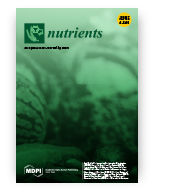Association of Dietary Patterns, Suspected Sarcopenia, and Frailty Syndrome among Older Adults in Poland - A Cross-Sectional Study
Robert Gajda; Marzena Jeżewska-Zychowicz; Ewa Raczkowska; Karolina Rak; Małgorzata Szymala-Pędzik; Łukasz Noculak; Małgorzata Sobieszczańska
Nutrients
Ministerial score = 140.0
Journal Impact Factor (2023) = 4.8 (Q1)
 Background: The association of sarcopenia and frailty syndrome with dietary patterns is not yet well recognized. The aim: The aim of the study was to evaluate the association among dietary patterns, suspected sarcopenia, and frailty syndrome among older people in Poland. Methods: The study was conducted in 2022 and 2023 among people aged 55 and older. The sample was chosen arbitrarily. The following questionnaires were used in the study: the KomPAN (assessment of frequency of food intake and sociodemographic characteristics), the SARC-F (assessment of risk of sarcopenia), and the EFS (diagnosis of frailty syndrome). To confirm the suspicion of sarcopenia, muscle strength was assessed using the HGS and FTSST, and physical fitness was assessed using the GST. Based on the frequency of food consumption, 11 DPs (factors) were selected using PCA analysis. SARC-F, HGS, FTSST, and GST results were used to identify homogeneous groups (clusters) using cluster analysis, a k-means method. Results: Two clusters were identified: cluster 1 (the non-sarcopenic cluster, or nSC) and cluster 2 (the sarcopenic cluster, or SC). Associations between variables were assessed using logistic regression. Suspected sarcopenia was found in 32.0% of respondents, more in men than women, and more among those either over 75 or 65 and under. EFS results showed that the risk (22.1%) or presence of frailty syndrome (23.8%) was more common in men than women and more common in those aged 75 and older than in other age groups. Male gender; older age; and unfavorable dietary patterns, i.e., consumption of white bread and bakery products, white rice and pasta, butter, and potatoes (factor 1) and cheese, cured meat, smoked sausages, and hot dogs (factor 9), increased the likelihood of sarcopenia and frailty syndrome, while the pattern associated with fruit and water consumption (factor 7) had the opposite effect. Conclusions: Confirmation of the importance of dietary patterns in the etiology and pathogenesis of sarcopenia and frailty syndrome should be documented in prospective cohort studies.
Background: The association of sarcopenia and frailty syndrome with dietary patterns is not yet well recognized. The aim: The aim of the study was to evaluate the association among dietary patterns, suspected sarcopenia, and frailty syndrome among older people in Poland. Methods: The study was conducted in 2022 and 2023 among people aged 55 and older. The sample was chosen arbitrarily. The following questionnaires were used in the study: the KomPAN (assessment of frequency of food intake and sociodemographic characteristics), the SARC-F (assessment of risk of sarcopenia), and the EFS (diagnosis of frailty syndrome). To confirm the suspicion of sarcopenia, muscle strength was assessed using the HGS and FTSST, and physical fitness was assessed using the GST. Based on the frequency of food consumption, 11 DPs (factors) were selected using PCA analysis. SARC-F, HGS, FTSST, and GST results were used to identify homogeneous groups (clusters) using cluster analysis, a k-means method. Results: Two clusters were identified: cluster 1 (the non-sarcopenic cluster, or nSC) and cluster 2 (the sarcopenic cluster, or SC). Associations between variables were assessed using logistic regression. Suspected sarcopenia was found in 32.0% of respondents, more in men than women, and more among those either over 75 or 65 and under. EFS results showed that the risk (22.1%) or presence of frailty syndrome (23.8%) was more common in men than women and more common in those aged 75 and older than in other age groups. Male gender; older age; and unfavorable dietary patterns, i.e., consumption of white bread and bakery products, white rice and pasta, butter, and potatoes (factor 1) and cheese, cured meat, smoked sausages, and hot dogs (factor 9), increased the likelihood of sarcopenia and frailty syndrome, while the pattern associated with fruit and water consumption (factor 7) had the opposite effect. Conclusions: Confirmation of the importance of dietary patterns in the etiology and pathogenesis of sarcopenia and frailty syndrome should be documented in prospective cohort studies.
DOI:10.3390/nu16183090









